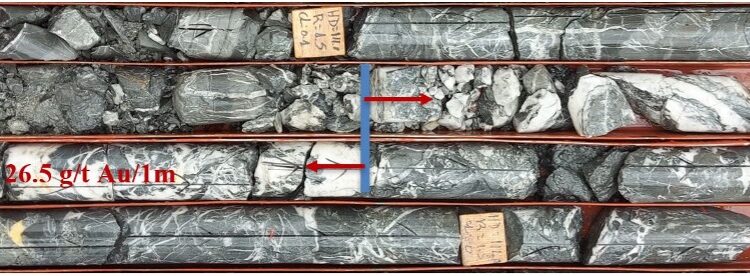Desert Gold Ventures Inc. (TSXV: DAU) has identified gold in results from the first RC/core hole drilled to test the Linnguekoto West Deposit, a metallurgical hole drilled into the Barani East Deposit and the first two holes drilled into the Mogoyafara South Deposit in Mali.
“I’m very pleased to have drilled our first three holes at Mogoyafara South and Linngeukoto West,” President and CEO, Jared Scharf, said.
“Drill results confirm and support the historic drilling done by Hyundai circa 2002. Obviously much more drilling is needed at these deposits as they have only been tested to shallow depths and are mostly open to depth and along strike to the North and South.
“The metallurgical test hole at Barani East returned significantly higher grades than anticipated which bodes well when or if mining is carried out in this area.”
The Linnguekoto West Zone, which hosts inferred mineral resources of 66,200 ounces of gold in 1.39 million tonnes of gold mineralisation grading 1.48 g/t gold, is located in the south-central part of the property.
One hole was drilled to acquire firsthand information as to the character of the zone. This hole returned a best intercept of 1.83 g/t Au over 27 metres including 2.25 over 20.7 metres and 26.5 g/t Au over 1.0 metres. As well, this hole returned a new gold lens intercept of 0.61 g/t Au over 23.8 metres,including 1.26 g/t gold over 5 metres and 0.64 g/t gold over 8.9 metres.
The zones are hosted by moderately to intensely fractured and quartz veined siltstones, shales, limestone and micro-conglomerate.
The Linnguekoto West Zone is interpreted to represent a steep-dipping higher-grade structure flanked by a series of shallow-dipping, gold-bearing dilational structures. More drilling is required to validate this model.
The Barani East metallurgical hole returned higher than expected grades returning 12.41 g/t gold over 45 metres (true width is unknown). Nearby holes, that intersected the zone returned 7.82 g/t gold over 13 metres, 5.66 g/t gold over 16 metres and 1.5 g/t gold over 25 metres and 1.58 g/t gold over 7.0 metres. (True width in these holes is estimated at 80-90% of drilled length).
The goal for this hole was to collect enough oxidised mineralisation in one hole for a series of metallurgical and geotechnical tests and as a result was drilled mostly down dip. Core from this hole will be used to evaluate the gravity gold, heap leach and geotechnical characteristics of the oxidized upper portion of the Barani East Zone.
Previous metallurgical work estimates gravity gold recoveries up to 64% with typical CN leach recoveries, together totalling up to 98.6%.
The final two holes of the program began the testing of the Mogoyafara South Zone with two pit areas tested with holes approximately 800 metres apart. Gold mineralised zones were intersected where expected with better than expected widths of mineralisation in hole KO-22-RC-001 with an intercept of 0.75 g/t Au over 17 metres (true widths estimated to be 88% of drilled width.
Based on holes, 25 metres on either side, an eight to10 metre wide zone was expected.
Most of the gold mineralisation in this hole is hosted by felsic intrusion. Less mineralisation than expected was intersected in hole KO-22-RC-002. This hole, however, ended in gold mineralisation, suggesting that the gold-bearing system is still open to depth. A significant amount of drilling is still required both to validate and test for zone extensions.
For further information please visit: https://www.desertgold.ca/











